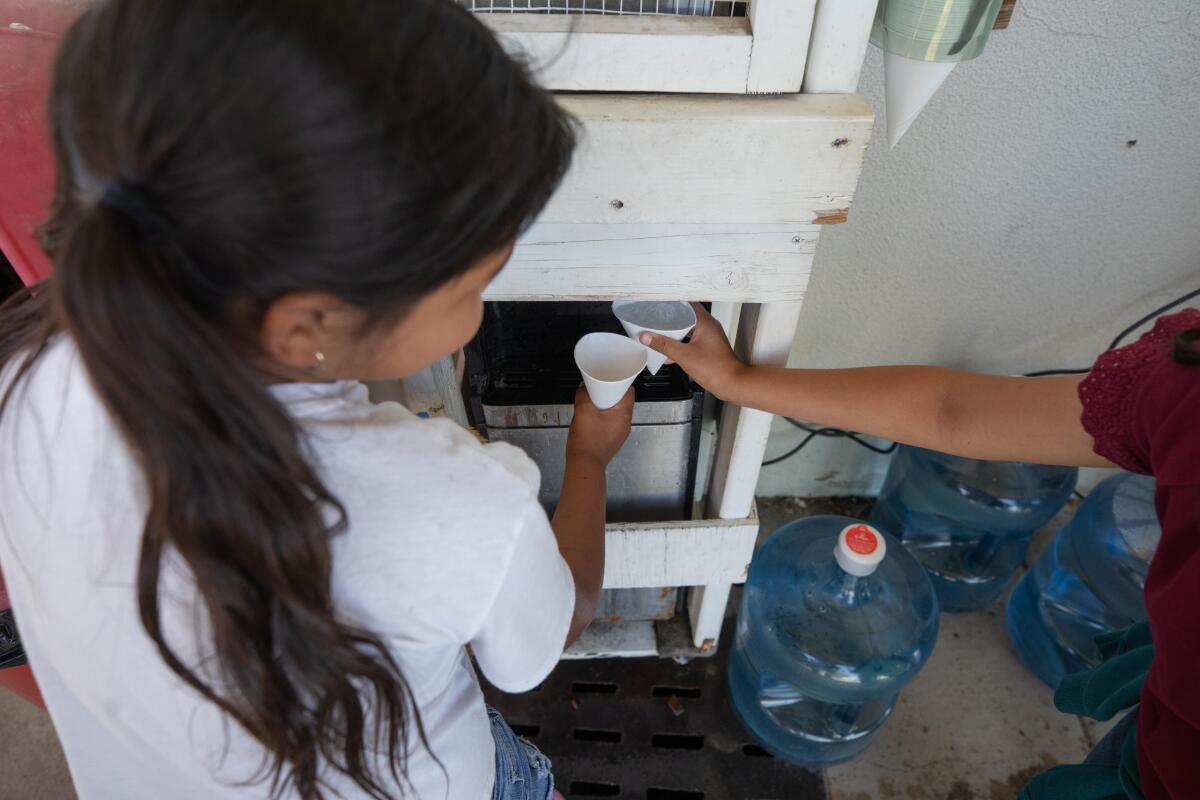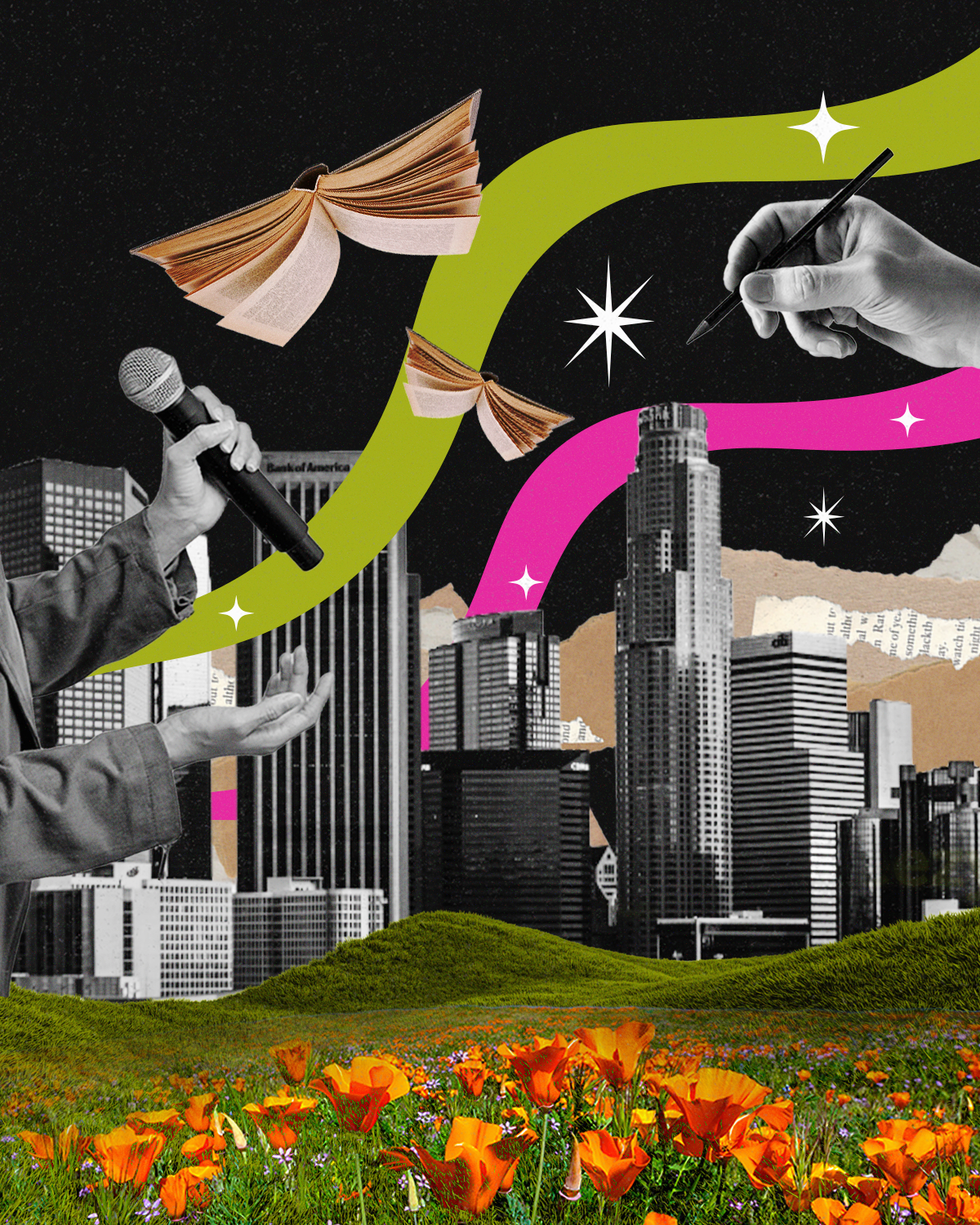Inside California’s struggle to provide safe drinking water for all

- Share via
Good morning. It’s Wednesday, Sept. 27. Here’s what you need to know to start your day.
- Safe drinking water remains elusive in some California communities
- A challenge to L.A.’s emergency declaration on homelessness
- The best places to hear Latinx poets in L.A.
- And here’s today’s e-newspaper
Sign up for Essential California
The most important California stories and recommendations in your inbox every morning.
You may occasionally receive promotional content from the Los Angeles Times.
California’s struggle to provide safe drinking water
I’m Dorany Pineda, a reporter writing about climate change and the environment.
More than a decade ago, California became the first state in the nation to legislatively recognize that all Californians have a right to clean, safe, accessible and affordable drinking water for cooking, drinking and sanitary needs. The state has poured resources and hundreds of millions of dollars into these efforts, partnering with organizations, community leaders and others to help. But for about a million residents, it remains an unrealized promise. Hundreds of water systems across the state are failing, and Kern County is bearing the brunt.
It’s a problem borne unequally. Of the state’s 381 failing water systems on Jan. 1, nearly 62% were located in disadvantaged or severely disadvantaged communities. About 70% served non-white customers, and of that, 83.5% were Hispanic.
In many cases, systems are failing because they are not meeting state and federal drinking water standards. The tap water in some people’s homes is laced with unsafe levels of contaminants that can cause cancer and other serious health issues.
I have spent the last year reporting on myriad issues surrounding water in California — including flooding that devastated the livelihoods of farmworkers; a historic drought that parched domestic wells in record numbers; and the millions of Californians bearing the brunt of soaring water costs.
While much of our coverage focused on quantity, my editor asked me to look into water quality.
With help from staff writers Ian James and Hayley Smith, and data reporters Katie Licari and Gabrielle LaMarr LeMee, we sought to understand the state’s challenges in providing this fundamental right.
Over the course of several visits to Kern County this spring, residents in towns and tiny, remote communities told me about the inconveniences, frustrations, financial burdens, health ailments and fears associated with contaminated water.
They told me about receiving frequent boil-water notices and getting pink eye infections from showering; about cloudy, sulfur-smelling water; and pets dying too young.
One woman told me she frequently drank from the tap, which contained up to eight times the arsenic levels the state allows, so she could save the twice-monthly clean water deliveries for her 5-year-old son to drink. They still boiled noodles and vegetables with the tap because she couldn’t afford to buy more water.
Some families, such as Maria Martinez’s, are overwhelmed by environmental pollution, and contaminated tap water is part of that burden.
A retired farmworker who still occasionally works, Martinez lives a few blocks from an oil refinery. She said she gets frequent sore throats and eye irritation after breathing the air outside. Some mornings in the fields, the wine grape vines glisten with pesticides. Her hair falls out and her hands dry from working, she said. There’s little respite inside — she wonders whether she’ll one day get sick from the tap water, which she drank until learning it contained levels of a potent carcinogen that exceeded drinking water standards.
State water regulators acknowledge the scope and complexity of the problems while also touting their progress in recent years. Since 2019, more than 200 systems that were failing to meet drinking water standards have been brought into compliance, benefiting more than 1.3 million people, one official told us. But an almost equal number of systems have failed in that time.
Droughts, climate change, aging systems, declining groundwater levels and new and forthcoming drinking water standards could further complicate the challenges and tip more systems to failure. Currently, about 520 water systems statewide serving more than 5.7 million people are at risk of failing, which one state water regulator acknowledged is “an unacceptably high number.”
But as one expert told me, the human right to water for all Californians is absolutely attainable. It’s just going to take more money, people, resources and political will than we’ve seen in the last 11 years.
Today’s top stories

Housing and homelessness
- L.A.’s mayor declared a homeless emergency. A new lawsuit says it should be repealed.
- L.A. County offered 3,000 new mental health and substance use treatment beds in a bid to end a lawsuit.
Politics
- Tony Thurmond announced he’ll run for governor in 2026.
- United Farm Workers endorsed President Biden for reelection.
Guns in California
- Gov. Gavin Newsom signed gun laws that add new taxes and limit where owners can carry firearms.
- Culver City bought a gun store, just two blocks from school, to stop another from taking its place.
Nagorno-Karabakh
- Thousands of ethnic Armenians are fleeing Nagorno-Karabakh after the Azerbaijani military took control of the enclave.
- Armenians’ fury over Azerbaijan’s recapture of Nagorno-Karabakh has focused on Armenian Prime Minister Nikol Pashinyan. Could his government go next?
- Armenian Americans say another genocide underway, and have demanded sanctions
More big stories
- In Men’s Central Jail, fires are common. Smoke alarms are not.
- Which major California city has the highest rate of car thefts? Hint: It’s not Los Angeles.
- A man shot by LAPD officers who mistook his cellphone for gun won $2.35 million in damages.
- UAW aims for drivers’ attention by striking parts warehouses, including two in the Inland Empire.
- Working-class Echo Park residents have joined forces to battle a parking nightmare due to a yoga studio.
- Wayne Ratkovich, a developer who saved some of L.A.’s best-known architectural gems, died at 82.
- Over a dozen Hells Angels members were indicted in a brutal attack on three Black men in San Diego.
- Powerball jackpot jumps to $835 million. What are your odds of winning?
Get unlimited access to the Los Angeles Times. Subscribe here.
Commentary and opinions
- Michael Hiltzik: Jeffrey Epstein reaches from the grave to expose how JPMorgan profited from his sex trafficking.
- Dylan Hernández: Mike Trout wants to stay with the Angels. That’s why they need to move him.
- Mark Z. Barabak: Sen. Menendez needs to go. Democrats show Republicans how to deal with a rotten apple.
- Editorial: Voters said no to ending money bail in 2020. Why is L.A. County doing it anyway?
Today’s great reads
Column: After a ‘hot labor summer,’ Black Hollywood is confronting the limits of solidarity.
Even as the strikes dragged on for months, upending budgets and stressing households, there’s an important long-term question for Black folks in the entertainment industry: What will come of all this solidarity we’ve seen on the picket lines?
Other great reads
- The Hollywood writers’ strike is over. Why was it so hard to get a deal done?
- Column: Hollywood is ready to go back to work. But Hollywood is never going back to normal.
- USC players recount harrowing moments from Bronny James’ cardiac arrest.
How can we make this newsletter more useful? Send comments to essentialcalifornia@latimes.com.
For your downtime

Going out
- 🎤 The best places to hear Latinx poets in Los Angeles.
- 🏃Malibu Triathlon, set for this weekend, gets last-minute go-ahead from City Council.
- 🥬 Need more veggies? The Times’ Jenn Harris shares some of her favorite healthy restaurant meals.
- 😘 Speed dating is so popular in L.A. right now. But is it for you?
Staying in
- 📺 ‘CoComelon’ introduces new bilingual series ‘Nina’s Familia.’
- 🎵 Alan Palomo shelves the Neon Indian name and mines the 1980s in a new album.
- 📙 During lockdown, a California novelist’s hit debut felt like a curse. It also inspired her.
- 🥘 Here’s a recipe for Malcolm Lee’s chicken curry.
- ✏️ Get our free daily crossword puzzle, sudoku, word search and arcade games.
And finally ... a great photo
Show us your favorite place in California! Send us photos you have taken of spots in California that are special — natural or human-made — and tell us why they’re important to you.

Today’s great photo is from Christopher Kox of San Francisco: The Palace of Fine Arts. Christopher writes:
This is the very well known Palace of Fine Arts, in the Marina District of San Francisco. The Palace was built for the Pan Pacific Exposition in 1915, and is the sole remaining structure from that “world’s fair.” This picture includes my 1963 Alfa Romeo — a California car from the day it was imported from Italy in 1963.... The car, as well as the Palace, are emblematic of California — as is the deep blue and clear sky just before sunrise in April.
Have a great day, from the Essential California team
Ryan Fonseca, reporter
Elvia Limón, multiplatform editor
Kevinisha Walker, multiplatform editor
Laura Blasey, assistant editor
Check our top stories, topics and the latest articles on latimes.com.
Sign up for Essential California
The most important California stories and recommendations in your inbox every morning.
You may occasionally receive promotional content from the Los Angeles Times.








